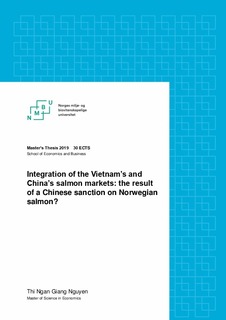| dc.description.abstract | China’s sanction, in the forms of stricter border controls against Norwegian salmon, was allegedly applied in response to the Nobel Peace Prize for 2010. Based on official trade data, the sanction seemed to succeed in restricting direct imports of Norwegian salmon into China. However, Norwegian salmon may have been re-exported or transshipped to China through a third country, for example, Vietnam. Because there are no reports on re-exports or legal transshipments from Vietnam to Norway, smuggling, a means of illegal transshipment, might have occurred.
In March 2011, Vietnam’s salmon import volume from Norway increased by more than three times. It has even surpassed China’s salmon import volume from Norway in many months since then. Vietnam’s strange behavior in salmon trade with Norway has occurred a few months after China’s first document that discriminatorily targets Norwegian salmon. By estimating the model of Vietnam’s import demand function, the study found that the sudden change in Vietnam’s salmon trade pattern with Norway cannot be explained by general trade theory.
This thesis is an attempt to establish the relationship between what has happened to imports of Norwegian salmon in Vietnam and China’s alleged sanction and the effect of the sanction on China’s salmon imports from Norway. The sanction acts as a structural break that divides the study period from July 1997 to December 2018 into two sub-periods. Lags of change in China’s import volume of Norwegian salmon have negatively significant effects on, or “Granger cause”, change in Vietnam’s after the sanction, but not before the sanction. This finding implies a statistical link between an increase (decrease) in Vietnam’s salmon imports from Norway and a decrease (increase) in China’s salmon imports from Norway due to the sanction, leading to price convergence in the long run. Therefore, the study gives statistical evidence that Vietnam’s and China’s salmon markets have become integrated as a result of China’s alleged sanction on Norwegian salmon. If so, market integration has happened in an unexpected manner because of an illegal sanction-bursting strategy, smuggling. | nb_NO |

